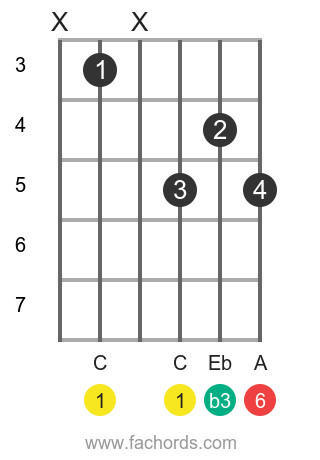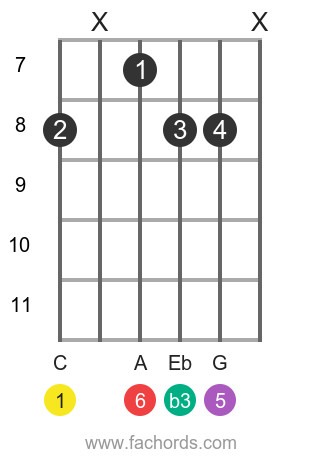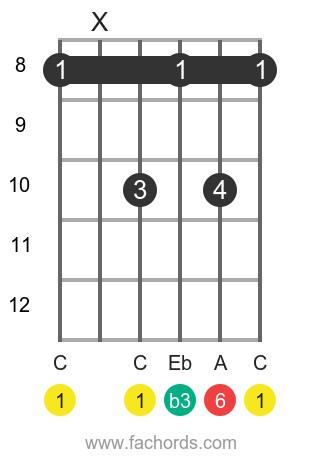The Cm6 guitar chord, also known as C minor sixth, adds a rich, melancholic flavor to your guitar playing. It’s a beautiful chord that expands beyond basic minor chords, offering a sophisticated sound often heard in jazz, blues, and pop music. This guide will explore the Cm6 chord in detail, providing you with chord diagrams, theoretical understanding, and practical tips to master it on your guitar.
Understanding the C Minor Sixth Chord
The Cm6 chord is built upon four notes: C, Eb, G, and A. These notes are derived from specific intervals relative to the root note (C), which are:
- 1 (Root): C
- ♭3 (Minor Third): Eb
- 5 (Perfect Fifth): G
- 6 (Major Sixth): A
Understanding these intervals is key to grasping the construction of the Cm6 chord. If you’re new to chord intervals, exploring resources like a fretboard intervals tutorial can significantly enhance your understanding of guitar music theory. The Cm6 chord belongs to the family of sixth chords, which you can learn more about in our comprehensive sixth guitar chords tutorial. For a deeper dive into chord naming conventions based on intervals, our guitar chords notation tutorial is an invaluable resource.
Let’s visualize the Cm6 chord in different positions on the guitar fretboard. Below are common shapes, ranging from easier to more challenging, including movable and barre chord forms. Remember to check out our tutorial on how to read chord diagrams if you’re unfamiliar with them. If barre chords present a challenge, our Bar Chords Tips guide offers practical advice to help you.
Cm6 Chord Positions on the Guitar
Position 1: Movable Shape
 Cm6 guitar chord diagram position 1
Cm6 guitar chord diagram position 1
This first position is a movable shape, meaning you can slide it up and down the neck to create different minor 6th chords. It’s a great starting point for beginners as it avoids barre chords. Focus on ensuring each note rings clearly.
Position 2: Movable Shape
 Cm6 guitar chord diagram position 2
Cm6 guitar chord diagram position 2
Position 2 offers another movable shape, providing a different voicing of the Cm6 chord. Experiment with both Position 1 and Position 2 to hear how the subtle changes in note arrangement affect the overall sound.
Position 3: Barre Chord Shape (Movable)
 Cm6 guitar chord diagram position 4
Cm6 guitar chord diagram position 4
This position introduces a barre chord, making it slightly more challenging but also more versatile. Barre chords are crucial for playing chords in various positions across the neck. Mastering this shape will significantly expand your chord vocabulary.
Position 4: Barre Chord Shape (Movable)
 Cm6 guitar chord diagram position 1
Cm6 guitar chord diagram position 1
Position 4 presents another barre chord variation, again movable along the fretboard. Each barre chord shape provides a fuller, richer sound due to the involvement of more strings.
Position 5: Movable Barre Chord
 Cm6 guitar chord diagram position 3
Cm6 guitar chord diagram position 3
This final position is another barre chord, offering yet another voicing and feel for the Cm6 chord. Practice transitioning between these positions to develop fluidity and a comprehensive understanding of the Cm6 chord.
For even more Cm6 chord shapes and voicings, explore our all guitar chords online library. If you prefer offline resources, you can download our Free Guitar Chords Chart Pdf for a printable reference.
Exploring Cm6 Chord Tones Across the Fretboard
The fretboard map below displays the locations of each note within the Cm6 chord across the guitar neck. By understanding this map, you can create your own Cm6 chord voicings and improvisations.
[Fretboard map showing Cm6 chord tones]
This map highlights the C (1), Eb (♭3), G (5), and A (6) notes that constitute the Cm6 chord, allowing you to visualize and play the chord in countless ways.
Play Cm6 and Other Minor 6th Chords
Once you’re comfortable with the Cm6, explore other minor 6th chords by simply changing the root note. Here are a few to get you started:
C m6 | D m6 | E m6 | F m6 | G m6 | A m6 | B m6 | C#m6 | D#m6 | F#m6 | G#m6 | A#m6 | Abm6 | Bbm6 | Dbm6 | Ebm6 | Gbm6
By understanding the structure and practicing these different positions, you’ll be able to incorporate the beautiful Cm6 guitar chord and its variations into your musical repertoire, adding depth and sophistication to your playing. Happy strumming!
